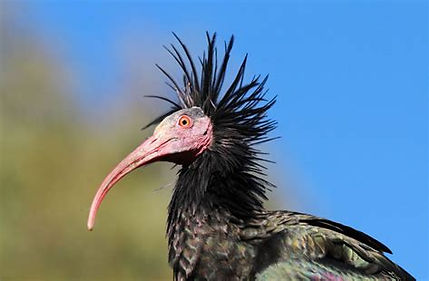
December 19 2021
waldrapp ibis
The waldrapp ibis has a mostly black plumage with iridescent shades of green, violet and blue. Their head and neck are red and featherless, with exception to a shaggy ruff of feathers around the base of the neck. Their long downward-curving bill is also red. The Waldrapp ibis used to be found across northern Africa and into the Middle East and Central Europe. Its population has now been reduced, however, to about 500 birds living in two small areas in Morocco. The only other sub-population to have survived into the 21stcentury – one that existed in Syria – appears to have died out. Waldrapp ibises are gregarious and social birds that gather in large flocks to forage and in colonies to breed. They prefer areas with sparse vegetation and can be found during the non-breeding season in mountain meadows, semi-arid ground, and high plateaus. There Lifespan is about 24 years. They use their long, curved beaks to peck on the ground and to probe in cracks and fissures for food.these birds are omnivores that go after a wide variety of animal prey, including insects, arachnids, scorpions, earthworms, snails, fish, amphibians, lizards, snakes, small rodents, and small birds, alive or dead. They also feed on vegetation such as berries, shoots, duckweed, and the rhizomes of aquatic plants. Between February and May, Waldrapp ibises gather in colonies of 40 or more birds to breed. They build their nests in remote rocky areas, cliffs, and escarpments. When the species was more plentiful, these ibises were also known to nest in castles, ruins, and walls, even in urban areas. Their nests are platform-style, made up of loose collections of sticks lined with grass. Females lay clutches of 2-4 eggs. Along with one other species of ibis, the waldrapp was considered sacred in ancient Egypt.

This species has been in decline for several centuries for reasons that are not entirely clear. In Morocco, its decline has been accelerated by illegal building and disturbance near breeding cliffs as well as farming practices that have disrupted feeding areas. However, the population in Morocco at present is considered stable, and the number of chicks hatched in recent years is on the rise.With their historical range dramatically reduced and with only one sub-population still surviving, Waldrapp ibises are listed as critically endangered by the IUCN, the world’s leading conservation organization. However, the population in Morocco is currently considered stable, which is a good sign. In 2006, an international species action plan for Waldrapp ibis was published that promotes captive breeding efforts in many countries, including the U.S. The Maryland Zoo participates in the AZA’s Species Survival Program for Waldrapp ibis, serving as a holding facility for males until they can be paired for breeding with females at other AZA institutions. Historically these birds had a large range; today, they exist in small areas in Morocco, Syria and Turkey. They are found mostly in open, dry areas but also inhabit coastlines, wetlands, shallow river banks and rocky areas. Waldrapp ibis are listed as critically endangered by the IUCN; in fact, they are among the world’s most endangered avian species. Once common across central Europe, northern Africa and the Middle East, they are now isolated to sites where only about 420 wild birds remain.
Waldrapp ibis are threatened by habitat loss as a result of wetland drainage and the creation of dams. Additionally, uncontrolled hunting, pesticides and climate change contribute to their population decline.
Thanks to an internationally coordinated Species Survival Plan, in which San Francisco Zoo participates, there are over 1,100 waldrapp ibis in captivity. Offspring from zoos have even been released back to the wild, so that some colonies in Turkey consist entirely of captive-hatched ibis.




June 12, 2018, Waldrapp ibis. The Maryland Zoo. Retrieved October 17, 2021, from https://www.marylandzoo.org/animal/waldrapp-ibis/.
Waldrapp Ibis: San Francisco Zoo & Gardens. San Francisco Zoo & Gardens |. (2021, October 16). Retrieved October 17, 2021, from https://www.sfzoo.org/waldrapp-ibis/.
Waldrapp Ibis. Dublin Zoo. (2021, March 4). Retrieved October 17, 2021, from https://www.dublinzoo.ie/animal/ibis/.

